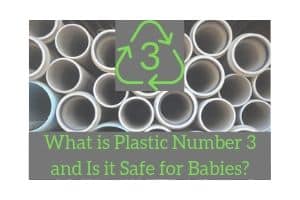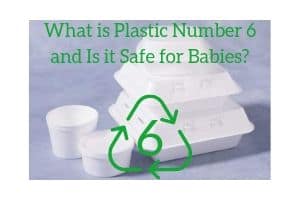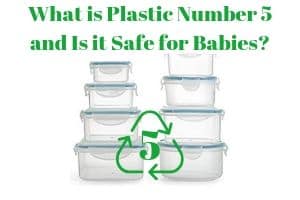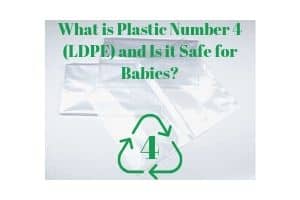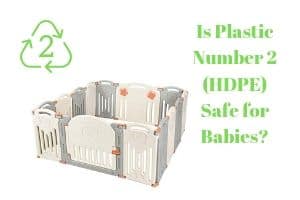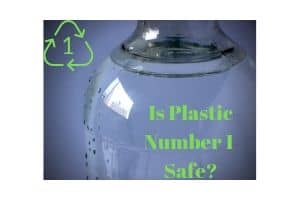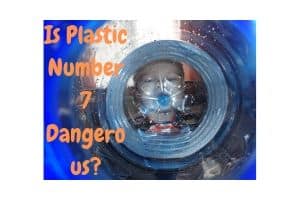There is so much plastic on store shelves today that it is challenging to figure out what is what. Because some plastics can be dangerous and others pretty safe, I decided to dive into all of the plastic number categories to provide the details you need to know. Today in the mini-series, we are covering plastic number 3 (PVC) to learn what it is and whether or not it is safe for babies.
Plastic number 3, otherwise known as Polyvinyl chloride (PVC), is an extremely common thermoplastic polymer. It is labeled a toxic plastic because it easily releases phthalates (endocrine disruptors) and chlorine, which can be absorbed through the air, skin contact, or ingestion.
Unfortunately, this is one of the plastics that we need to avoid at all costs, but that mission is easier said than done. Let’s dive into the details to see where we are likely to find PVC, how it’s made, and just how dangerous it is.
Table of Contents
What is plastic number 3 (PVC)?
If you have seen the triangular symbols on the bottom of plastic bottles, containers, and other items, then you might be wondering what it means. These symbols and numbers are actually resin identification codes (RIC), and they are put there to help recyclers figure out what kind of material they are dealing with before they try to process it. In most cases, manufacturers aren’t actually required to label this, but it’s good for us as the consumer when they do because it lets us know what we are dealing with as well!
Plastic items with the number 3 on the bottom are made from polyvinyl chloride, or PVC, which is one of the most common thermoplastic polymers in the world. It’s been around for a long time and used commercially as early as the 1920s by B.D. Goodrich. While it is naturally very hard and brittle, plasticizers can be added to make flexible versions. Praised for its durability, resistance to chemicals, and affordability, PVC is commonly found in construction sites. Unfortunately, it can also be found in many children’s’ toys and household items.
While many products will have the RIC listed, don’t depend on having that information since there is no regulation to make sure it’s available. The standard for these codes, maintained by the American Society for Testing and Materials (ASTM International) does a fairly good job of separating these plastics into nice categories, but using the standard is usually voluntary. Don’t be afraid to check a manufacturer’s website or pick up the phone to call about a product that you are unsure of!
How is PVC made?
The raw materials used to make PVC are taken from oil (ethylene) and salt (chlorine). When these two compounds are combined, they form ethylene dichloride which is then heated at extremely high temps to make vinyl chloride.
From that point, a whole host of chemicals can be added such as flame retardants, plasticizers, color pigments, and others depending on what the plastic is going to be used for and where it will be located. Once finished, the product will be extremely tough, difficult to burn, and impact resistant.
On the surface, it looks like a great material!
Does PVC plastic come from natural materials
While it might look like PVC plastic number 3 is made from natural materials (oil and salt), there are a whole host of other chemicals created during the manufacturing process that are harmful to humans and the environment. Here are a few:
- Dioxin – Classified as a persistent organic pollutant (POP), dioxins build up in the environment and bio-accumulate throughout the food chain. Adverse effects can include hormonal issues, infertility, cancer. It has also been linked to diabetes.
- Hydrochloric acid – A potent acid that can cause damage by releasing acidic mists into the air.
- Vinyl chloride – Another workplace hazard, this chemical can cause difficulty breathing and, over time, can lead to permanent liver damage and liver cancer.
In addition to these, we also have to worry about lead, cadmium, and organotins being released as well. These are common by-products of factories and plants.
If you want to learn more about what PVC plants and refining facilities can do to their surrounding environment, then you should check the impact noxious fumes and chemical by-products had on the people of Mossville, LA. The town was situated next to one of these facilities.
Is number 3 plastic safe for babies?
While there are some plastics that are relatively harmless, number three plastic is not one of them. In fact, PVC is often labeled as the ‘poison plastic’ among critics because of the damage it can cause. To make matters worse, babies can be exposed to the chemicals that leach from PVC through the air, skin contact, and even ingestion in the case of toys. According to the State of New Jersey Department Human Services, PVC contains cadmium, lead, and phthalates which are toxic chemicals for children.
Over the years there have been many studies that link PVC-related chemicals to developmental problems among children as well as an increased risk of certain kinds of disease. Here are a few of the results:
- A link between PVC flooring with asthma and autism. The chemicals 2-ethyl-l-hexanol and l-butanol were found to be released over time as the floor degraded.
- Phthalates released from PVC and asthma. Phthalates have also been linked to endocrine system disruption which can cause hormonal issues among children and adults.
- PVC wall covering and asthma
- A link between dioxins released from aging PVC and certain types of cancer. Dioxins found in some populations can cause cancer rates of 1-in-1000, which is incredibly high.
Aside from those specific cases, there have also been measurements of as many as forty different chemicals off-gassing from PVC flooring and wall coverings. Many of those chemicals were toxic.
Does PVC contain BPA?
Many different types of PVC plastic will have measurable amounts of BPA inside. This means that the BPA will leach out of number 3 plastic into food or beverages as well as through skin contact. There has been a lot of research into BPA, and it’s pretty much unanimously agreed that it is harmful stuff.
BPA has shown to cause negative effects on the human brain, development of the reproductive system, and increased blood pressure. Children and babies are a higher risk of suffering from these effects because so much of organ development takes place during the first few years of life. Compared to their weight, babies tend to eat and drink way more than adults as well – a bigger opportunity for exposure through ingestion. Also, babies tend to put most thing into their mouths which includes PVC toys, dirt, and other contaminants.
Is PVC toxic when heated?
Like many other plastics, PVC will release more chemicals into the air when it is heated. What’s worse, catching it on fire releases much more smoke than other materials and that smoke will include the dangerous dioxins that I mentioned earlier.
Common baby products made with plastic number 3 (PVC)
PVC is so common these days that its difficult to find an area of the house that doesn’t include them somewhere. Here is just a short list of places that you can find this plastic:
- Strollers and car seats
- Toys
- Labels, stickers, and wall clings
- Mattress covers
- Furniture
- Bibs and aprons
- Children’s swimming pools
- Garden hoses
- Inflatables
- Drinking straws and food storage containers
- Flooring, pipes, and tons of other construction-related pieces of your home
You’ll need to look carefully when it comes to purchasing baby items to avoid dangerous plastics such as PVC. That’s because most companies aren’t going to just go right out and say they are using a certain plastic if it could be perceived as dangerous.
To be sure, look for labels such as ‘PVC free,’ ‘BPA free,’ and ‘phthalate-free.’ You can also read more about the product on the back of the packaging or on the manufacturer’s website. If they are serious about protecting the chemical safety of your child, they will be telling you all about it whenever they get a chance!
Fortunately, most natural baby product companies these days will actively avoid PVC and other dangerous plastics in their baby toys and accessories. Unfortunately, many cut-rate companies that produce their products overseas with little safety oversight or regulation will probably not be so careful. For a good overview of baby products available without PVC or other dangerous plastics, search for baby products without PVC on Amazon. Results will include baby toys, clothing, and other accessories that you will be comforted to know won’t harm your baby. You will be surprised at what all can include dangerous plastic if you aren’t paying attention!
Learn more about the other plastic numbers
We’ve covered all of the details you need to know about plastic number 3 (PVC), but you might want to check out the next article in the series all about baby safety of plastic number 4 (LDPE). It’s a relatively safe plastic, but there are a few things you still need to know about it!

